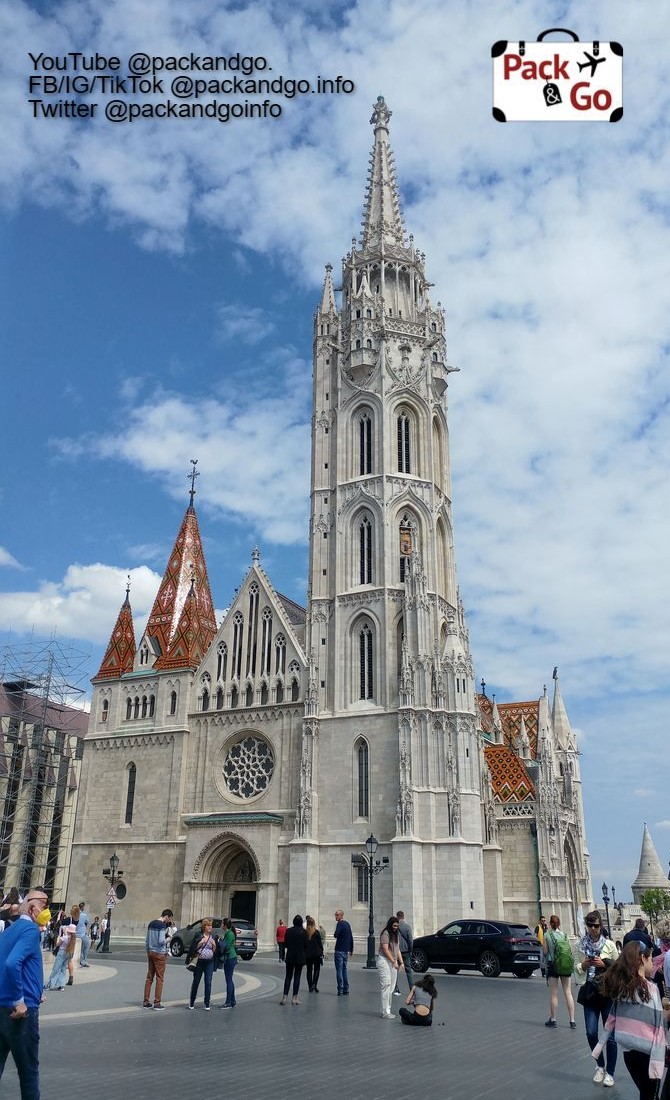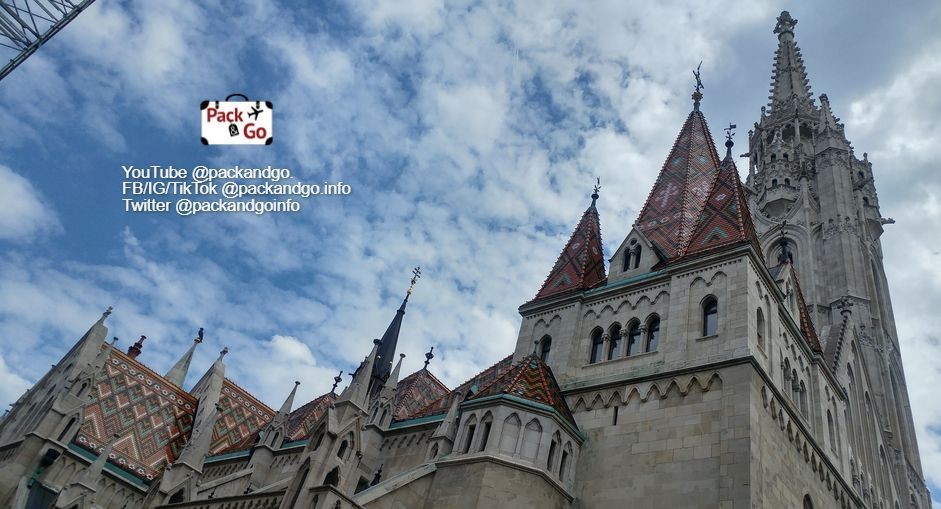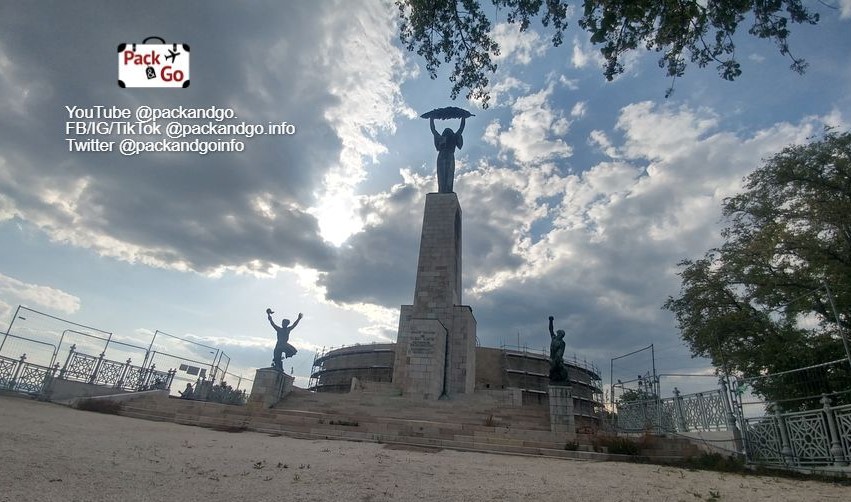Time in Budapest is awesome! We love traveling slowly because we can balance our schedules. Some days, we explore as if there is no tomorrow. We finish those days very happy but physically destroyed, blister-feet to say the least. Others, we can dedicate time to only contemplate a landscape or people around us from the bench or the grass of a park. Sometimes, in cities like Budapest, we like to walk without a fixed direction and we just merge in with the first bunch of people we find. We go where local people go following their pace, listening to languages we don’t understand much, smelling people’s favorite perfumes, and pleasant and bad smells around; feeling the hot, the wind, or the rain, and filling our eyes with all types of images, colors, and textures. It is fun to stop once all the rest have already found their destination and it is only us again!

The Hungarian friends we are visiting live exactly in the Buda side of Budapest. We have shared very nice walks on this cool and calm side of the city. Besides, with the time we have spent here, we are feeling it a bit like home. Now, we already have our favorite bakery, ice cream shop, coffee place, chimney cake shop, park, etc. It is very easy to fall in love with Budapest, guys!
To write about everything here could be massively long, so we preferred, first, to dedicate a complete article only to Pest and now, to Buda. And then, give you 5 reasons powerful enough to visit this side of the city and make you crave more! This short but lovely selection can be your starting point or a guide in case you come for a day or a weekend.
What is the difference between Buda and Pest?
Only separated by the Danube, Buda, and Pest shape the beautiful Hungarian capital, Budapest. But every side has its personality. Generally talking, Pest is flat and Buda has hills, so you can enjoy nice panoramic views of the city.

Pest is the side of the city where you can find people, fun, bars, and movement all day and at night. Buda is more relaxed, greenish, and ornamented with that imperial touch that makes it look like a scene from a fairy tale. Buda is a perfect escape from the city within the city!

You can know more about Buda and Pest history here.
| Follow PackAndGo.info at: | |
| YouTube | @packandgo. |
| @packandgo.info | |
| @packandgoinfo | |
| @packandgo.info | |
| TikTok | @packandgo.info |
5 Reasons to Fall in Love with the Buda Side of Budapest
Let’s get started:
Fisherman’s Bastion
The Fishermen’s Bastion is a place you must visit. It is a huge and magical place. The Bastion's very long, wide, and meandering stairs drive you to nice balconies, columns, towers, huge statues, and a great terrace. Be sure that wherever you look you find something nice and interesting to see. There is history here but also a very pleasant beauty for your senses. We love this place! And we can bet you will love it too. You don’t have to be an architect or an art expert, the Fisherman’s Bastion will catch you totally! And if you are such an expert, its neo-romantic and neo-gothic style will captivate you!

We recommend you explore it as much as possible because there is a lot to see. You will feel like walking into a fairy-tale castle rather than in a fortification. And once you enjoy it, you still have a lot more to see around. From here you have some of the most amazing panoramic views of the city, the Danube, and the Parliament included.
The Fisherman's Bastion was built in 1895 and was named after the medieval guild of fishermen who were responsible for defending this section of the city walls. The terrace is made up of seven towers, each representing one of the seven Magyar tribes that settled in the Carpathian Basin in the 9th century. You can admire during hours the stunning architecture and take in the views of the city from the terrace.

On this terrace, there is a small café that can be considered a tourist trap. Yes, it is nothing "wow" but it is easy to fall there for a beer, coffee, or simple sandwich as an excuse to admire the astonishing view.

Buda Castle
There is no fairy tale without a castle, so Buda castle is one of the most famous landmarks of Hungary and has been listed as a UNESCO World Heritage Site. The castle has a rich history dating back to the 14th century and has been rebuilt multiple times. It houses several museums such as the Hungarian National Gallery and the Budapest History Museum, which showcase the country's art and history. Again, this is a place that, besides its architecture and value, will give you great panoramic views of the city to enjoy from the castle's terrace.

If you are into museums, you have a lot to see there. If not, you still will love the calm atmosphere and walking on the grounds of the castle. These spaces sometimes host gastronomic and wine festivals. Depending on the season, you can find more or fewer extra activities there. You also will find different statues, monuments, and stories. For instance, the “Turul Modár”, is a bird that looks like a falcon or an eagle. It is the protagonist of a myth that says it impregnated Emese, the grandmother of the military commander who led the Magyar tribes into the Carpathian Basin around AD 895. His name was Árpád.

Matthias Church
The Mattias Church is an impressive building, a Roman Catholic church, located in the heart of the Castle District of Buda. It is a cool example of Gothic architecture and has a rich history dating back to the 14th century. Once, it was even a mosque! Ottoman Turks used it as a mosque for 150 years. The church has undergone several renovations throughout the centuries and has been used as a coronation church for Hungarian kings. You can admire its intricate frescoes and stained glass windows, as well as the ornate altar and pulpit.

We liked a lot the ceramic tiles it has on the top. We were said, they came from a famous factory called Zsolnay. These tiles were a modern addition (19th century) and a great touch in our opinion. Now it is a key part of this building’s personality. There is a small museum inside but what we enjoyed the most was the building itself.

First, it was dedicated to Our Lady or Mary, but in the 19th century, it was named Matthias Church. It honors Matthias Corvinus, a Hungarian king who promoted the Renaissance (Italian) in Hungary.
Gellért Hill
Now we will push you to climb! Yes, you should climb the Gellért Hill (235 meters high) because the exercise is good for the body, the surroundings are very pleasant, and the views of the city, its bridges, and the great Danube are amazing!

You can take either a longer but easier route that starts on a pathway close to the Géllert Baths or you can go to the stairs nearby the Elizabeth bridge. This hill was named after Saint Gerard or Gellért. History says that in the 10th century, he was put inside a barrel and thrown down from the top of the hill. It was his punishment for attempting to convert pagan Magyars to Christianity.
This calm and nice hill houses important landmarks like the Géllert’s monument right at the hill’s bottom, the Liberty statue erected in 1947 to commemorate the Soviet Liberation of Hungary, and the Citadel, a fortress built in 1851.

People go there during the day but also at night. You can reach the top by tram or bus, but we recommend you climb it to the top! The panoramic views will be a rewarding experience for you!
Rudas Thermal Bath
The Rudas Thermal Bath is a historic bath built in the 16th century during the Ottoman occupation of Hungary and has been in use ever since. The bath offers several pools, including an octagonal pool with a dome, and is fed by natural hot springs. Many locals and visitors go looking for the healing properties of the thermal waters or only for relaxing time in the cool setting of the bath.
Thermal baths are a tradition deeply ingrained in the Hungarians' lifestyle. Everywhere you go in this country, you will find thermal baths, some working during the whole year. This tradition started in Roman times when Romans discovered the healing properties of mineral waters. Later, the tradition did not stop but the opposite, and during the 150 years of Ottoman rule, some of the most stunning bathhouses were constructed.
Now, there are newer and modern complexes but we felt more attracted to the traditional and oldest. Honestly, during our first visit to Budapest, we skipped this experience because it looked to us like a visit to a crowded water park. But through time and knowing more about Hungary and its people, we got that is a different experience. Nowadays, baths include steam rooms, saunas, and regular cold pools too. Some truly look like water parks, while others keep a bit of past essence so you feel like taking part in a sort of ancient ritual. Their architecture is interesting and a trip to the past.
People go to relax or heal in the hot mineral water, some gather with friends in these places, have a pleasant and quiet time for themselves, play chess on floating chessboards, or have a party there. Yes! You also can go to a party or a dating party to a Hungarian bath. Szechenyi Spa § Baths is popular due to its “sparties”, organized especially on Summer nights (Saturdays). So it seems there is a Hungarian thermal bath for every taste and purpose.
We went to Rudas Thermal Bath. Honestly, we hesitated and planned a lot for this visit. We were warned that pools could be crowded during the weekends, but it can happen at any time. Being our first trip during the current pandemic, we did not feel attracted at all by the idea of being like sardines in the steamy water.
So we checked prices, conditions, and schedules online and made a combination that luckily worked! We chose a coed bath to enjoy the experience together (you can choose a bath for men only or women only so nudity is the etiquette). For a coed bath, a bathing suit is a must. And we went on a Thursday (working day). We arrived punctually at 1 pm when the second shift of the bath’s schedule started that day, betting that at 1 pm, people should be busy at work. Besides, entrance fees are cheaper than during the weekends.
Luckily, there were only a few other humans there, no more than six, and that relaxed us. There are six pools and the water has different temperatures. We went directly to the original baths (indoor). We had seen many pictures of it on the Internet. To get into that place is “wow”, guys! These baths date back to 1550! Its original shape has changed through time, there have been some additions, renovations but honestly, you walk into centuries of history there. The most attractive spot for us so far was the octagonal pool, with the dome sustained by those pillars (8). The water there comes from the ground and it has sulfate, sodium, and calcium magnesium-hydrogen. It is like a set for a movie! And that creates a unique atmosphere and boosts the experience a lot!
People in charge of the place told us this mineral water helps to treat neuralgia, disc herniation, arthritis, calcium deficiency in the bones, and degenerative joint diseases.
Hopefully the two hours we spent there improved our health or rejuvenated us a bit! Hahaha. What we know for sure is that it was a relaxing and different experience. After a short lapse, we got used to the funny smell (like sulfur) around haha. In the beginning, we chatted between us, as quietly as possible because it was very silent. But soon after we stopped talking, we were just feeling the hot water, and almost falling asleep haha.
It is hard to quit and you can have a relaxing full day there because there are different amenities you can enjoy. The newer pools, sauna, different types of massages (aroma, refreshing, peeling, water, etc.), pedicure services (medical and spa), and the drinking hall where you can try the popular “drinking cures”. There are 3 choices, the Juventus water that supposes to help premature aging and high blood pressure. The Hungária is believed a water healer for stomach and kidney issues. And the Attila which is water from the spring considered the richest in terms of minerals.
We only spent two hours there because suddenly, a big group arrived at our pool. Currently, we can’t be surrounded by many people or too close without freaking out. Besides, M was already hungry! Hahaha Not strange!
You must try thermal baths in Hungary at least once. Don’t forget to take your sandals and towel, and swim cap for the pools. In Rudas and most baths you can buy or rent these items but better if you take yours. That night we slept like babies!
Conclusion
These are 5 reasons to fall in love with the Buda Side of Budapest. Buda is very charming! A great complement for the Pest side. There is no way you don’t crave more time in the beautiful Hungarian capital.
| Follow PackAndGo.info at: | |
| YouTube | @packandgo. |
| @packandgo.info | |
| @packandgoinfo | |
| @packandgo.info | |
| TikTok | @packandgo.info |
Follow our trip and remember, if you have the chance to travel, don’t hesitate, just pack and go!
Check more cool articles about Budapest, Hungary:
